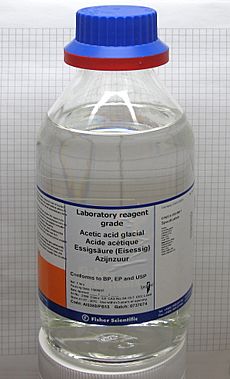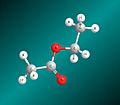Solvent facts for kids

A solvent is a substance, that becomes a solution by dissolving a solid, liquid, or gaseous solute. A solvent is usually a liquid, but can also be a solid or gas. The most common solvent in everyday life is water.
Most other commonly-used solvents are organic (carbon-containing) chemicals. These are called organic solvents. Solvents usually have a low boiling point and evaporate easily or can be removed by distillation, thereby leaving the dissolved substance behind. Solvents should therefore not react chemically with the dissolved compounds - they have to be inert. Solvents can also be used to extract soluble compounds from a mixture, the most common example is the brewing of coffee or tea with hot water. Solvents are usually clear and colorless liquids and many have a characteristic smell. The concentration of a solution is the amount of compound that is dissolved in a certain volume of solvent. The solubility is the maximal amount of compound that is soluble in a certain volume of solvent at a specified temperature.
Common uses for organic solvents are in dry cleaning (e.g. tetrachloroethylene), as paint thinners (e.g. toluene, turpentine), as nail polish removers and glue solvents (acetone, methyl acetate, ethyl acetate), in spot removers (e.g. hexane, petrol ether), in detergents (citrus terpenes), in perfumes (ethanol), and in chemical syntheses. Inorganic solvents are used in research chemistry and in a few technological processes.
Contents
Chronic health effects
Some solvents including chloroform and benzene (an ingredient of gasoline) are carcinogenic. Many others can damage internal organs like the liver, the kidneys, or the brain.
General precautions
- Avoiding the generation of solvent vapors by working in a fume hood, local exhaust ventilation (LEV), or a well ventilated area
- Keeping the storage containers tightly closed
- Never using open flames near flammable solvents, use of electrical heating instead
- Never flush flammable solvents down the drain to avoid explosions and fires
- Avoiding the inhalation of solvent vapors
- Avoiding contact of the solvent with the skin – many solvents are easily absorbed through the skin. They also tend to dry the skin and may cause sores and wounds.
Properties table of common solvents
The solvents are grouped into non-polar, polar aprotic, and polar protic solvents and ordered by increasing polarity. The polarity is given as the Dielectric constant. The density of nonpolar solvents that are heavier than water is bolded.
| Solvent | Chemical Formula | Boiling point | Dielectric constant | Density |
|---|---|---|---|---|
| Non-Polar Solvents | ||||
| Hexane | CH3-CH2-CH2-CH2-CH2-CH3 | 69 °C | 2.0 | 0.655 g/ml |
| Benzene | C6H6 | 80 °C | 2.3 | 0.879 g/ml |
| Toluene | C6H5-CH3 | 111 °C | 2.4 | 0.867 g/ml |
| Diethyl ether | CH3CH2-O-CH2-CH3 | 35 °C | 4.3 | 0.713 g/ml |
| Chloroform | CHCl3 | 61 °C | 4.8 | 1.498 g/ml |
| Ethyl acetate | CH3-C(=O)-O-CH2-CH3 | 77 °C | 6.0 | 0.894 g/ml |
| Dichloromethane | CH2Cl2 | 40 °C | 9.1 | 1.326 g/ml |
| Polar Aprotic Solvents | ||||
| 1,4-Dioxane | /-CH2-CH2-O-CH2-CH2-O-\ | 101 °C | 2.3 | 1.033 g/ml |
| Tetrahydrofuran (THF) | /-CH2-CH2-O-CH2-CH2-\ | 66 °C | 7.5 | 0.886 g/ml |
| Acetone | CH3-C(=O)-CH3 | 56 °C | 21 | 0.786 g/ml |
| Acetonitrile (MeCN) | CH3-C≡N | 82 °C | 37 | 0.786 g/ml |
| Dimethylformamide (DMF) | H-C(=O)N(CH3)2 | 153 °C | 38 | 0.944 g/ml |
| Dimethyl sulfoxide (DMSO) | CH3-S(=O)-CH3 | 189 °C | 47 | 1.092 g/ml |
| Polar Protic Solvents | ||||
| Acetic acid | CH3-C(=O)OH | 118 °C | 6.2 | 1.049 g/ml |
| n-Butanol | CH3-CH2-CH2-CH2-OH | 118 °C | 18 | 0.810 g/ml |
| Isopropanol | CH3-CH(-OH)-CH3 | 82 °C | 18 | 0.785 g/ml |
| n-Propanol | CH3-CH2-CH2-OH | 97 °C | 20 | 0.803 g/ml |
| Ethanol | CH3-CH2-OH | 79 °C | 24 | 0.789 g/ml |
| Methanol | CH3-OH | 65 °C | 33 | 0.791 g/ml |
| Formic acid | H-C(=O)OH | 100 °C | 58 | 1.21 g/ml |
| Water | H-O-H | 100 °C | 80 | 1.000 g/ml |
Images for kids
See also
 In Spanish: Disolvente para niños
In Spanish: Disolvente para niños


